| Revision as of 18:30, 5 May 2024 editDl2000 (talk | contribs)Autopatrolled, Extended confirmed users, New page reviewers, Pending changes reviewers, Rollbackers822,273 editsm need ref; tidyTag: Reverted← Previous edit | Revision as of 18:50, 5 May 2024 edit undoAnomieBOT (talk | contribs)Bots6,588,967 editsm Dating maintenance tags: {{Fact}}Tag: RevertedNext edit → | ||
| Line 390: | Line 390: | ||
| ]]] | ]]] | ||
| ] is the most popular sport on the island, led by the Palma-based ] club ], who play at the ], and ] club ].{{fact}} | ] is the most popular sport on the island, led by the Palma-based ] club ], who play at the ], and ] club ].{{fact|date=May 2024}} | ||
| Basketball is also a popular sport. Palma's top team is ], which plays its home games at the 5,076 capacity ].{{fact}} | Basketball is also a popular sport. Palma's top team is ], which plays its home games at the 5,076 capacity ].{{fact|date=May 2024}} | ||
| Because of its maritime location, all sea sports have a big presence in Palma. Perhaps the most important sporting event in the city is the Ciutat de Palma Prizes.{{citation needed|date=February 2023}} | Because of its maritime location, all sea sports have a big presence in Palma. Perhaps the most important sporting event in the city is the Ciutat de Palma Prizes.{{citation needed|date=February 2023}} | ||
| ] is popular in Mallorca. An international race for professional cyclists, the ], is held in February, the first day of which consists of a circuit race around the streets of Palma. The city is also home to the ], a multi-platinum venue featuring a velodrome. The arena also hosted the ] tennis event.{{fact}} | ] is popular in Mallorca. An international race for professional cyclists, the ], is held in February, the first day of which consists of a circuit race around the streets of Palma. The city is also home to the ], a multi-platinum venue featuring a velodrome. The arena also hosted the ] tennis event.{{fact|date=May 2024}} | ||
| In June 2016, the city of Palma participated in the First World Company Sports Games which included five days of culture, sport, and inclusivity within the community of Mallorca as a whole. It was operated through the World Federation Company Sport and was promoted for both local people and tourists to come together in the city. It became a large business venture by offering packages including accommodations close to the events and additional tourism information for future events.{{citation needed|date=February 2023}} | In June 2016, the city of Palma participated in the First World Company Sports Games which included five days of culture, sport, and inclusivity within the community of Mallorca as a whole. It was operated through the World Federation Company Sport and was promoted for both local people and tourists to come together in the city. It became a large business venture by offering packages including accommodations close to the events and additional tourism information for future events.{{citation needed|date=February 2023}} | ||
| In 2023 Palma hosted the ].{{fact}} | In 2023 Palma hosted the ].{{fact|date=May 2024}} | ||
| ] | ] | ||
| Line 410: | Line 410: | ||
| * ] | * ] | ||
| * The city bus system, which includes a loop line through the historic centre, is run by the EMT (See external link below). | * The city bus system, which includes a loop line through the historic centre, is run by the EMT (See external link below). | ||
| * There is also a bus system run by the TIB. This includes routes to and from the municipalities Calvià and Palma.{{fact}} | * There is also a bus system run by the TIB. This includes routes to and from the municipalities Calvià and Palma.{{fact|date=May 2024}} | ||
| * In the City of Palma there is a fleet of 1246 taxis. All are equipped with air conditioning and most of them have a radiotelephone station, with four existing companies: Taxis Palma Radio, Radio-Taxi Ciutat, Taxi Teléfono and Taxis adapted for users with reduced mobility. Until the change of colour regulated through the Municipal Decree No. 19985 of 15 October 1999, the taxis of Palma for 50 years had been of the characteristic black and ivory colours. Currently, they are white.{{fact}} | * In the City of Palma there is a fleet of 1246 taxis. All are equipped with air conditioning and most of them have a radiotelephone station, with four existing companies: Taxis Palma Radio, Radio-Taxi Ciutat, Taxi Teléfono and Taxis adapted for users with reduced mobility. Until the change of colour regulated through the Municipal Decree No. 19985 of 15 October 1999, the taxis of Palma for 50 years had been of the characteristic black and ivory colours. Currently, they are white.{{fact|date=May 2024}} | ||
| ==Twin towns – sister cities== | ==Twin towns – sister cities== | ||
Revision as of 18:50, 5 May 2024
City in the Balearic Islands, Spain This article is about the city in Mallorca. For other similar names, see Palma (disambiguation).Capital city and municipality in Balearic Islands, Spain
| Palma | |
|---|---|
| Capital city and municipality | |
 View from Bellver Castle View from Bellver Castle Cathedral Cathedral Bellver Castle Bellver Castle Railway of Sóller Railway of Sóller Palma City Hall Palma City Hall | |
 Flag Flag Coat of arms Coat of arms | |
| Nickname: Ciutat de Mallorca (commonly shortened to Ciutat) | |
| Location of Palma | |
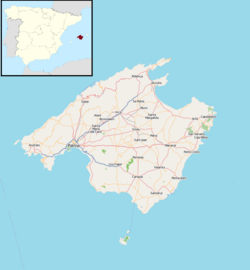   | |
| Coordinates: 39°34′N 2°39′E / 39.567°N 2.650°E / 39.567; 2.650 | |
| Country | Spain |
| Autonomous community | Balearic Islands |
| Province | Balearic Islands |
| Island | Majorca |
| Comarca | Palma |
| Judicial district | Palma |
| Founded | 124 BC |
| Administrative HQ | Palma City Hall |
| Government | |
| • Type | Municipal corporation |
| • Body | Ajuntament de Palma |
| • Mayor | Marcos Rojo (PP) |
| Area | |
| • Capital city and municipality | 208.63 km (80.55 sq mi) |
| Elevation | 13 m (43 ft) |
| Population | |
| • Capital city and municipality | 409,661 |
| • Density | 2,000/km (5,100/sq mi) |
| • Urban | 550,000 |
| Demonym(s) | palmesà, -ana (ca) palmesano, -na (es) |
| GDP | |
| • Metro | €21.456 billion (2020) |
| Time zone | UTC+1 (Central European Time) |
| • Summer (DST) | UTC+2 (Central European Summer Time) |
| Postal code | 070XX |
| Dialing code | 971 |
| Website | www.palma.es |
Palma (Template:IPA-ca; Template:IPA-es), also known as Palma de Mallorca (officially between 1983 and 1988, 2006–2008, and 2012–2016), is the capital and largest city of the autonomous community of the Balearic Islands in Spain.
The city is situated on the south coast of Mallorca on the Bay of Palma. The Cabrera Archipelago, though widely separated from Palma proper, is administratively considered part of the municipality.
History
Roman period
After the conquest of Mallorca, the city was loosely incorporated into the province of Tarraconensis by 123 BC; the Romans founded two new cities: Palma on the south of the island, and Pollentia in the northeast – on the site of a Phoenician settlement. Whilst Pollentia acted as a port to Roman cities on the northwestern Mediterranean Sea, Palma was the port used for destinations in Africa, such as Carthage, and Hispania, such as Saguntum, Gades and Carthago Nova. Though present-day Palma has no significant remains from this period, occasional archaeological finds are made in city centre excavations. For example, the remains of the Roman Wall can be seen at Can Bordils, the Municipal Archive, and below it, at the Maimó ben Faraig Center.
Muslim period
Between 902 and 1229, the city was under Islamic control. It remained the capital of the island and it was known as Medina Mayurqa, which in Arabic means "City of Majorca".
Dénia—Balearic taifa (1015–1087)

The Umayyad regime, despite its administrative centralisation, mercenary army and struggle to gain wider social support, could neither harmonise the various ethnic groups inside al-Andalus nor dissolve the old tribes which still organised sporadic ethnic fighting. During the 11th century, the Caliphate's control waned considerably. Provinces broke free from the central Cordoban administration and became effectively sovereign states — taifas — under the same governors that had been named by the last Umayyad Caliphs. According to their origin, these "taifas" can be grouped under three broad categories: people of Arab, Berber or Slavic origin.
Balearic Taifa (1087–1115) and Western Mediterranean
The Banu Hud conquest of Dénia and its incorporation to the Eastern District of the taifa of Zaragoza meant the destruction of the legacy of Muyahid. The islands were freed from mainland dominion and briefly enjoyed independence, during which Medina Mayurqa was the capital.The economy during this period depended on both agriculture and piracy. In the latter 11th century, Christian commercial powers took the initiative at sea against the Muslims. After centuries of fighting defensively in the face of Islamic pressure, Italians, Catalans and Occitans took offensive action. Consequently, the benefits of piracy diminished causing severe economic stress to the city.
Period of the Banu Ganiya (1157–1203)

The Banu Ganiya, taking advantage of the great loss suffered by Abu Yuqub Yusuf in the Siege of Santarém, attacked Ifriqiya, where the Almohad dominion had not been consolidated yet, in the same year. However, this attack was repelled and the Almohad authorities encouraged anti-Almoravid revolts in the Islands. The city was captured by the Almohads in 1203.
Christian reconquest and late Middle Ages

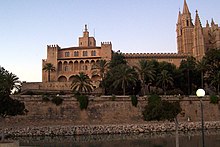

On 31 December 1229, after three months of siege, the city in the Conquest of Majorca by James I of Aragon was renamed Ciutat de Mallorca (Mallorca City). In addition to being kept as the capital of the Kingdom of Majorca, it was given a municipality that comprised the whole island. The governing arm was the University of the City and Kingdom of Majorca. After the death of James I of Aragon, Palma became the joint capital of the Kingdom of Majorca, together with Perpignan. His son, James II of Majorca, championed the construction of statues and monuments in the city: Bellver Castle, the churches of St. Francesc and St. Domingo, reformed the Palace of Almudaina and began the construction of the Palma Cathedral.
In 1391, anti-Jewish riots broke out. The Jewish community of Inca was completely wiped out, as were those of Sóller, Sineu, and Alcudia. Despite the governor's prohibition on leaving the island, many Jews fled to North Africa. The remaining Jews were forced to convert under the threat of death.
The city's advantageous geographical location allowed it extensive commerce with Catalonia, Valencia, Provence, the Maghreb, the Italian republics, and the dominions of the Great Turk, which heralded a golden age for the city.
At the beginning of the 16th century, the Rebellion of the Brotherhoods (a peasant uprising against Charles V's administration) and the frequent attack of Turkish and Berber pirates caused a reduction of commercial activities and a huge investment in defensive structures. As a consequence, the city entered a period of decadence that would last till the end of the 17th century. Catalina Tomas, a canoness and mystic who became later one of the patron saints of Mallorca, lived in the convent of St Mary Magdalene of Palma between 1550 and 1572.
17th to 19th centuries

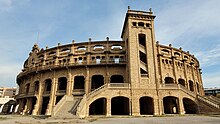
The 17th century was characterised by the division of the city into two sides or gangs, named Canamunts and Canavalls (from Majorcan Catalan "the ones from the upper/lower side"), with severe social and economic repercussions. During this period, the port became a haven for pirates. During the last quarter of the century, the Inquisition continued its persecution of the city's Jews, locally called xuetes. Xuetes practiced strict endogamy by marrying only within their own group. Many of their descendants observe a syncretism known as Xueta Christianity.
Mass tourism
Since the advent of mass tourism in the 1950s, the city has been transformed into a tourist destination and has attracted many workers from mainland Spain. This has contributed to a huge change in the city's traditions, its language, and its economic power. The boom in tourism has caused Palma to grow significantly. In 1960, Mallorca received 500,000 visitors, in 1997 it received more than 6,739,700. In 2001 more than 19,200,000 people passed through Son Sant Joan airport near Palma, with an additional 1.5 million coming by sea. In the 21st century, urban redevelopment, by the so-called Pla Mirall (English "Mirror Plan"), had attracted groups of immigrant workers from outside the European Union, especially from Africa and South America. More than half the population, approximately 80 percent, work in tourism which is therefore the main economic portal of Palma. Tourism has affected the rapid economic growth of Palma, placing the island of Mallorca among the wealthier regions in Spain.Template:¢itation needed
The second economic portal of Palma is agriculture. The main exports of Palma's agriculture are almonds, oranges, lemons, and olives. The island is also gifted with a wide variety of natural resources, such as mines of copper, lead, and marble. The city also has several surrounding neighborhood communities including Establiments, Nord, Son Espanyol, Ces Cases Noves, and Sa Creu Vermella. In October 2021 Palma was shortlisted for the European Commission's 2022 European Capital of Smart Tourism award along with Bordeaux, Copenhagen, Dublin, Florence, Ljubljana and Valencia.
Population
According to the 2022 census, the population of the city of Palma proper was 415,940, and the population of the entire urban area was 550,000, making it the twelfth largest urban area of Spain. By the start of 2019, the population of the city had risen to 416,065. Almost half of the total population of Mallorca lives in Palma.
As of 2017 over 60,000 non-Spanish foreigners registered with the town hall lived in Palma; the registered foreign population from 2016 to 2017 declined by 832, the numerically highest decline in the Balearics.
Geography

Palma is a major city and seaport located in the southwest of Mallorca, a western Mediterranean island belonging to the Balearic Islands archipelago. The land area of the city is about 21.355 square kilometres (8.245 sq mi) with an altitude of 13 metres (43 feet) above sea level.
The city center of Palma is located north of the homonymous bay (Badia de Palma in the local Catalan language). The area that extends eastwards is mostly a flat fertile plain known as Es Pla. To the north and west, the city borders the Serra de Tramuntana, the island's major mountain range, and a Unesco World Heritage site.
Climate
Palma has a Hot-summer Mediterranean climate (Köppen: Csa) with an average annual temperature of 18.2 °C (65 °F). During the coldest month, January, the average high temperature is 15.4 °C (60 °F), while the average low is 8.3 °C (47 °F). In the warmest month, August, the average high temperature is 29.8 °C (86 °F), while the low is 22.5 °C (73 °F). Autumn is the wettest season, with occasional heavy rainfall and storms. The average sunshine hours are around 2800 per year. There is a significant maritime influence, so the city has mild winters and hot but not extreme summers. The surrounding continental landmasses can warm up the offshore sea surface temperatures and as a result, the small confines of Mallorca are still able to build up and sustain heat despite being on an island. There is vast seasonal lag, especially in late summer courtesy of the seawater peaking in temperatures long after the summer solstice. Extreme temperatures are rare for the influence of the sea. Freezes are extremely rare, as the port of Mallorca has only registered once a low temperature below freezing (−0.1 °C (32 °F) in February 2012), as well as Mallorca, has never gone above 38 °C (100 °F) in any summer month since temperature records began in 1978. The average temperature of the sea in Mallorca is 19.5 °C (67 °F) and the beach weather normally lasts about 6–7 months, from late April to early November.
| Climate data for Palma de Mallorca, Port (1981-2010), extremes (1978-2021) (Satellite view) | |||||||||||||
|---|---|---|---|---|---|---|---|---|---|---|---|---|---|
| Month | Jan | Feb | Mar | Apr | May | Jun | Jul | Aug | Sep | Oct | Nov | Dec | Year |
| Record high °C (°F) | 24.2 (75.6) |
24.4 (75.9) |
26.6 (79.9) |
28.0 (82.4) |
32.0 (89.6) |
36.5 (97.7) |
38.0 (100.4) |
37.8 (100.0) |
35.5 (95.9) |
31.2 (88.2) |
27.6 (81.7) |
23.4 (74.1) |
38.0 (100.4) |
| Mean daily maximum °C (°F) | 15.4 (59.7) |
15.5 (59.9) |
17.2 (63.0) |
19.2 (66.6) |
22.5 (72.5) |
26.5 (79.7) |
29.4 (84.9) |
29.8 (85.6) |
27.1 (80.8) |
23.7 (74.7) |
19.3 (66.7) |
16.5 (61.7) |
21.8 (71.2) |
| Daily mean °C (°F) | 11.9 (53.4) |
11.9 (53.4) |
13.4 (56.1) |
15.5 (59.9) |
18.8 (65.8) |
22.7 (72.9) |
25.7 (78.3) |
26.2 (79.2) |
23.5 (74.3) |
20.2 (68.4) |
15.8 (60.4) |
13.1 (55.6) |
18.2 (64.8) |
| Mean daily minimum °C (°F) | 8.3 (46.9) |
8.4 (47.1) |
9.6 (49.3) |
11.7 (53.1) |
15.1 (59.2) |
18.9 (66.0) |
21.9 (71.4) |
22.5 (72.5) |
19.9 (67.8) |
16.6 (61.9) |
12.3 (54.1) |
9.7 (49.5) |
14.6 (58.3) |
| Record low °C (°F) | 0.0 (32.0) |
−0.1 (31.8) |
1.6 (34.9) |
4.4 (39.9) |
8.0 (46.4) |
11.0 (51.8) |
16.4 (61.5) |
15.8 (60.4) |
10.0 (50.0) |
8.4 (47.1) |
3.8 (38.8) |
2.5 (36.5) |
−0.1 (31.8) |
| Average precipitation mm (inches) | 43 (1.7) |
37 (1.5) |
28 (1.1) |
39 (1.5) |
36 (1.4) |
11 (0.4) |
6 (0.2) |
22 (0.9) |
52 (2.0) |
69 (2.7) |
59 (2.3) |
48 (1.9) |
449 (17.7) |
| Average precipitation days (≥ 1 mm) | 6 | 6 | 5 | 5 | 4 | 2 | 1 | 2 | 5 | 7 | 6 | 7 | 53 |
| Mean monthly sunshine hours | 167 | 170 | 205 | 237 | 284 | 315 | 346 | 316 | 227 | 205 | 161 | 151 | 2,779 |
| Percent possible sunshine | 54 | 55 | 55 | 61 | 66 | 70 | 75 | 73 | 63 | 60 | 54 | 54 | 62 |
| Source: Agencia Estatal de Meteorología | |||||||||||||
| Climate data for Palma | |||||||||||||
|---|---|---|---|---|---|---|---|---|---|---|---|---|---|
| Month | Jan | Feb | Mar | Apr | May | Jun | Jul | Aug | Sep | Oct | Nov | Dec | Year |
| Average sea temperature °C (°F) | 14.4 (57.9) |
13.9 (57.0) |
14.1 (57.4) |
15.9 (60.7) |
18.9 (66.1) |
22.5 (72.5) |
24.9 (76.7) |
26.0 (78.8) |
25.0 (77.1) |
22.7 (72.9) |
19.7 (67.4) |
16.3 (61.4) |
19.5 (67.2) |
| Mean daily daylight hours | 10.0 | 11.0 | 12.0 | 13.0 | 14.0 | 15.0 | 15.0 | 14.0 | 12.0 | 11.0 | 10.0 | 9.0 | 12.2 |
| Average Ultraviolet index | 2 | 3 | 5 | 6 | 8 | 9 | 9 | 8 | 6 | 4 | 2 | 2 | 5.3 |
| Source: seatemperature.org | |||||||||||||
| Source: Weather Atlas | |||||||||||||
Sights

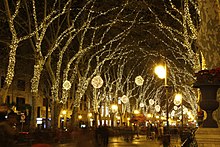
Plaça d'Espanya
The Plaça d'Espanya is the transport hub of Palma. The Estació Intermodal caters to buses and trains (the latter controlled by TIB). The two old buildings are home to the tourist information centre and several cafés sit on either side of the two large escalators which lead into the Estació, which sits underneath a large and popular park. On the lawns are several glass boxes, which let in light and ventilation to the station below ground. There are also train-themed playing structures, each one shaped like a train carriage and named after towns along the line of the Ferrocarril de Sóller, a railway dating back to 1911 which has its Palma Station right next to the park. Just down the street from here a new bus station is under construction. At the centre of the plaza is a statue of James I, Conquistador of Majorca.
Cathedral area
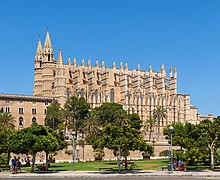
Palma is famous for La Seu, its vast cathedral built on a previous mosque which was built atop an original Christian church. Although construction of the present Cathedral began in 1229, it did not finish until 1601. Catalan architect Antoni Gaudí was drafted to restore the building in 1901. The Parc de la Mar (Park of the Sea) lies just south, overlooked by the great building which sits above it on the city's stone foundations. Between the two are the town walls.
Old city

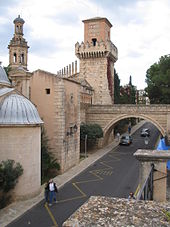
The Old City (in the southeast area of Palma behind the cathedral) is a maze of streets clearly hinting at an Arab past. Except for a few streets and squares which allow traffic and are populated with tourists most of the time, the walkways of this city quarter are fairly narrow, quiet streets, surrounded by a diverse range of interesting buildings, the architecture of which is comparable to cities such as Florence. The majority are private houses, some of which are open to the public as discreet museums or galleries. The Old City is also home to the Ajuntament (or Town Hall), the Convent of the cathedral, and the Banys Àrabs.
Banys Àrabs

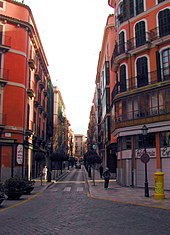
The Banys Àrabs, or Arab Baths, one of the few remnants of Palma's Moorish past, are accessed via the quiet Ca'n Serra street near the Convent of the cathedral, and include the lush gardens of Ca'n Fontirroig, home to Sardinian warblers, house sparrows, cacti, palm trees and a wide range of flowers and ferns. The small two-roomed brick building that once housed the baths is of Byzantine origin, dating back to the 11th century.
Notable people
Notable people who were born in the city include the following individuals:
- Rafael Nadal (born 1986), Tennis player and 22- time grand slam champion
- Álex Abrines (born 1993), basketball player for the Oklahoma City Thunder
- Marco Asensio (born 1996), footballer for Paris Saint-Germain
- Rudy Fernández (born 1985), basketball player for Real Madrid
- Lorenzo Fluxá (born 2004), racing driver
- Ramon Llull (c. 1232 – c. 1315/16), philosopher and writer
- Jorge Lorenzo (born 1987), motorcyclist and five-time MotoGP champion
- Joan Mir (born 1997), motorcyclist and Moto 3 and MotoGP champion
- Guillermo Pont (born 1921), footballer
- Luis Salom (1991–2016), motorcyclist
- Agustí Villaronga (1953–2023), filmmaker
- Rossy de Palma (born 1964), actress
- Margalida Caimari Vila (1839–1921), poet
- Izan Guevara (born 2004), motorcyclist
Sports

Football is the most popular sport on the island, led by the Palma-based La Liga club Real Mallorca, who play at the Estadi de Son Moix, and Segunda División B club CD Atlético Baleares.
Basketball is also a popular sport. Palma's top team is CB Bahía San Agustín, which plays its home games at the 5,076 capacity Palau Municipal d'Esports Son Moix.
Because of its maritime location, all sea sports have a big presence in Palma. Perhaps the most important sporting event in the city is the Ciutat de Palma Prizes.
Road cycling is popular in Mallorca. An international race for professional cyclists, the Vuelta a Mallorca, is held in February, the first day of which consists of a circuit race around the streets of Palma. The city is also home to the Palma Arena, a multi-platinum venue featuring a velodrome. The arena also hosted the Battle of Surfaces tennis event.
In June 2016, the city of Palma participated in the First World Company Sports Games which included five days of culture, sport, and inclusivity within the community of Mallorca as a whole. It was operated through the World Federation Company Sport and was promoted for both local people and tourists to come together in the city. It became a large business venture by offering packages including accommodations close to the events and additional tourism information for future events.
In 2023 Palma hosted the 2023 UEFA Futsal Champions League Finals.
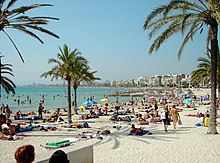
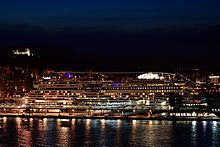
Transport
- Palma de Mallorca Metro
- Mallorca rail network
- Palma de Mallorca Airport
- The city bus system, which includes a loop line through the historic centre, is run by the EMT (See external link below).
- There is also a bus system run by the TIB. This includes routes to and from the municipalities Calvià and Palma.
- In the City of Palma there is a fleet of 1246 taxis. All are equipped with air conditioning and most of them have a radiotelephone station, with four existing companies: Taxis Palma Radio, Radio-Taxi Ciutat, Taxi Teléfono and Taxis adapted for users with reduced mobility. Until the change of colour regulated through the Municipal Decree No. 19985 of 15 October 1999, the taxis of Palma for 50 years had been of the characteristic black and ivory colours. Currently, they are white.
Twin towns – sister cities
Palma de Mallorca is twinned with Portofino, Italy, Alghero, Italy and Naples, Italy.
See also
- Cort Library
- Duchess of Palma de Mallorca
- Edwin Lewis Snyder, "Spain's Magic Island", The Architect and Engineer, 110:10, 37–45, August 1932
- List of municipalities in Balearic Islands
References
- ^ "Demographia: World Urban Areas — April 2017" (PDF) (13th Annual ed.). Archived from the original on 17 May 2017.
- Municipal Register of Spain 2018. National Statistics Institute.
- "Gross domestic product (GDP) at current market prices by metropolitan regions". ec.europa.eu.
- Since December 2016 the city is officially "Palma", "Llei 15/2016, de 2 de desembre, de modificació de la Llei 23/2006, de 20 de desembre, de capitalitat de Palma de Mallorca" [Law 15/2016, of 2 December, of modification of Law 23/2006 of 20 December, capital of Palma de Mallorca] (in Catalan). Govern de les Illes Balears. Archived from the original on 8 March 2021. Retrieved 18 January 2018.
- "Palma de Mallorca?" (in Catalan). Bibiloni.net. Archived from the original on 23 July 2011. Retrieved 10 April 2011.
- "Municipal Archive of Palma". Municipality of Palma (in Spanish). Archived from the original on 29 March 2019. Retrieved 29 March 2019.
Restos de la muralla romana se muestran descubiertos en la fachada lateral de Can Bordils
- "The New Yorker reviving Jewish life on a holiday island". BBC. 18 August 2019.
- Delamont, Sara (2002). Appetites and Identities: An Introduction to the Social Anthropology of Western Europe. Taylor & Francis. p. 114. ISBN 9781134924745.
- "Majorca". Jewish Virtual Library.
- Yuste, Belén; Rivas-Caballero, Sonnia L. "Santa Catalina Tomás". Real Academia de la Historia. Retrieved 3 November 2023.
- "Santa Catalina Tomás". Canónica de Santa Mª Magdalena. Retrieved 3 November 2023.
- Moore, Kenneth (1976). Those of the Street - The Catholic-Jews of Mallorca: a Study in Urban Cultural Change. Michigan University Press. p. 46. ISBN 9780674037830.
- "Majorca Economy - Information on Business and Investment in Majorca". www.majorca.com. Retrieved 14 November 2016.
- "Google Maps". Google Maps. Retrieved 12 January 2017.
- "2022 European Capital of Smart Tourism - Competition winners 2022". European Commission. 2 October 2021. Retrieved 8 November 2022.
- "INEbase Padrón - Población por municipios". INE Instituto Nacional de Estadística. Retrieved 8 June 2023.
- Instituto Nacional de Estadística, Madrid, 2019.
- "British and German foreign communities decreasing". Majorca Daily Bulletin. 19 January 2018. Retrieved 31 August 2018.
- ^ "Valores climatológicos normales. Palma. Puerto". January 2022.
- ^ "Valores extremos. Palma, Puerto". AEMET. Retrieved 5 January 2022.
- Ltd, Copyright Global Sea Temperatures - A-Connect. "Palma Water Temperature - Spain - Sea Temperatures". World Sea Temperatures.
- "Palma de Mallorca Sea Temperature". seatemperature.org. Retrieved 15 March 2017.
- "Palma, Spain - Climate data". Weather Atlas. Retrieved 15 March 2017.
- Tisdall, Nigel (2003). "Section 1 – Plaça d'Espanya – description of statue of James I". Mallorca. Thomas Cook Publisher. p. 48. ISBN 9781841573274.
- IIHS Rough Writing Guides. 2020. doi:10.24943/rwg.2020.
- "Mallorca Culture: Muslim Water system". majorcadailybulletin.com. 29 March 2021. Retrieved 24 October 2021.
- Vacca, Maria Luisa. "Comune di Napoli - Gemellaggi" [Naples - Twin Towns]. Comune di Napoli (in Italian). Archived from the original on 22 July 2013. Retrieved 8 August 2013.
Further reading
See also: Bibliography of the history of PalmaExternal links
- Official website Playa de Palma Mallorca
- Palma de Mallorca´s city council Archived 12 January 2012 at the Wayback Machine
- Official website for Tourism in Mallorca
| Articles related to Palma de Mallorca | ||||||||||||||||||||||||||||||||||||||||||||||||||||||||||||||||||||||||||||||||||||||||||||||
|---|---|---|---|---|---|---|---|---|---|---|---|---|---|---|---|---|---|---|---|---|---|---|---|---|---|---|---|---|---|---|---|---|---|---|---|---|---|---|---|---|---|---|---|---|---|---|---|---|---|---|---|---|---|---|---|---|---|---|---|---|---|---|---|---|---|---|---|---|---|---|---|---|---|---|---|---|---|---|---|---|---|---|---|---|---|---|---|---|---|---|---|---|---|---|
| ||||||||||||||||||||||||||||||||||||||||||||||||||||||||||||||||||||||||||||||||||||||||||||||